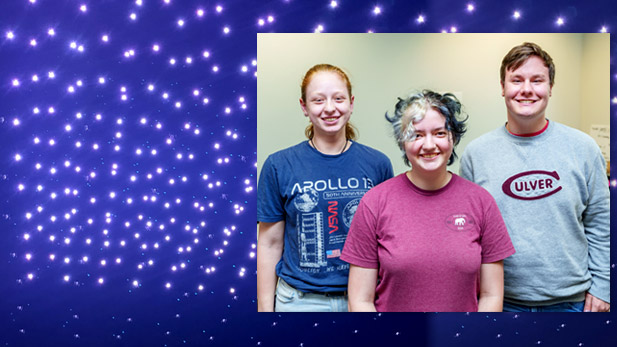Pierce Aerospace and Rose Ventures Partnership Takes Flight with Super Bowl Security Drones

Brooke Spurlock, V Brunkow, and Theo Mitz (pictured L-R) were among a group of Rose-Hulman Ventures student interns who worked on development of Pierce Aerospace’s Remote ID drones, which provided security for Super Bowl LVII and were used in a post-game light show.
There was something different about Super Bowl LVII this past February in Glendale, Arizona. While the Kansas City Chiefs defeated the Philadelphia Eagles at State Farm Stadium, Pierce Aerospace’s Remote ID drones were flying high in the sky helping secure the airspace for the big game. This was the first time a Remote ID was used in operational support of a National Special Security Event. This endeavor would not have been possible without the partnership Pierce Aerospace has with Rose-Hulman Institute of Technology.
Pierce Aerospace is an Indianapolis-based start-up that develops world-leading Remote ID solutions for unmanned aircraft systems (UAS) and low-altitude airspace monitoring sensors and services. For the Super Bowl, the company worked with the Department of Homeland Security and other federal, state and local agencies to deploy its Bluebird Remote ID receivers and B1 Remote ID beacons around State Farm Stadium.
But before the Super Bowl was even a possibility, Pierce’s Remote ID solution had to be developed and engineered. Enter Rose-Hulman Ventures.
Led by a team of engineers, software developers and designers, and supported by skilled Rose-Hulman student interns, Rose-Hulman Ventures works with clients ranging from individual entrepreneurs to Fortune 500 corporations. In this instance, Pierce Aerospace and Ventures formalized a partnership in late 2020 and development began on the Remote ID systems that would eventually be deployed at Super Bowl LVII.
Over the course of two years, 20 student interns, whose majors included electrical, computer, software and mechanical engineering, worked in coordination with the Pierce team on the hardware, firmware and software development of the Remote ID project. Together, they developed Remote ID beacons and related components for unmanned aerial vehicles that holds industry leading performance capabilities.
“This was the first time Remote ID was used in such a large public event,” said Aaron Pierce, CEO and co-founder. “Nearly 73,000 fans were inside that stadium. All with cell phones and other WiFi and Bluetooth emitting devices, many of whom were streaming or uploading photos and video during the halftime show. … Our engineers successfully detected and tracked our Remote ID beacons with phones inside the stadium during this high-noise floor event.”
Pierce, whose connection to Rose goes back to his junior high school days when he would call the Ask Rose Homework Helpline, believes working with Ventures proved invaluable to creating this new and innovative technology.
“Our teams worked together to meet a very hard engineering challenge and produce what’s now known as highest-performing product on the market, exceeding twice the performance of other products out there,” he said.
The Federal Aviation Administration (FAA) now requires nearly all UAS to equip with Remote ID broadcast technology and will begin enforcing this requirement in March 2024. UAS required to broadcast Remote ID are all of those that weigh .55 to 55 pounds and all of those operating under the FAA’s Part 107 commercial rule. Pierce Aerospace is in production with the technology deployed at the Super Bowl and is selling them to fleet operators, individual operators, commercial companies, government and military entities and professional drone pilots.
These Rose-Hulman Ventures projects not only benefit the external company, but also provide tremendous value for Rose students, providing them with hands-on experience that connects to their academic major and future career interests.
Jonathan Labayo (CE, 2002) is one of the Rose-Hulman Ventures engineering managers who is involved in the Pierce Aerospace projects. He sees this project as a prime example of students applying their academic knowledge to gain practical project experience.
“The students did a lot of the outright engineering, working directly with Pierce to do initial testing, board layout, assembly of hardware,” said Labayo. “There was a lot of complexity involved in the receiver board and the students did the bulk of that work. … It takes academic skill to know what they’re doing, but also intuition. We advised on the projects, but the students are doing the core engineering, building, manufacturing and coding for the projects.”
Theo Mitz, a senior majoring in computer engineering, is an intern who worked on the Pierce Aerospace project. He was able to take a wide variety of skills he learned in classes and apply them to the Remote ID project.
“The hands-on experience Rose Ventures provides has been invaluable to me,” said Mitz. “With other internships, you may be under the direction for a small part of a project. At Ventures, we are the project, and we work on the engineering process. I’ve learned so much more about engineering during my time at Ventures.”
Rose interns also reap the benefit of working directly with Pierce leadership and engineers — an experience many students do not have at larger companies. Sandor Pethes (CS, 2002), an engineering manager who worked on the Pierce project, believes these projects are not only a great example of creating an engineering product for the company, but it also allows Pierce to gain exposure to a potential talent pipeline. In fact, two student interns were hired as Pierce employees after graduation.
Not only are several Pierce employees Rose alumni — including Chief Technology Officer Gary Bullock (EE, 1975) — but Pierce echoes the idea that the partnership has the benefit of workforce development.
“We look at the Rose students we engage with as potential hires as we continue to grow,” said Pierce. “It’s been great to bring in different skill sets and people together to see what’s a good fit and dive deeper into what we do at Pierce Aerospace.”